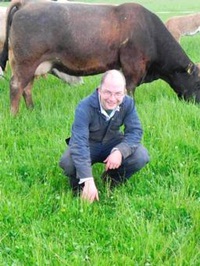![]()
Clover is a small plant with a big function. Red clover is becoming increasingly popular in organic farming but is not widely used outside of the organic sector. It is a relatively cheap source of fertility and something that should not be ignored by the conventional sector. As many organic farmers prepare to take their third silage cut of the year, they are delighted with how red clover has performed this year. Most farmers are recording protein levels of 16pc and will be hoping for 16-18t DM/ha.

Fixing nitrogen
Research shows that red and white clovers in high proportions in grass leys, can fix 150-250kg of useable nitrogen per ha per year. Red clover usually fixes more nitrogen than white clover in the first two years but after that results are similar. In order for swards to effectively produce high levels of nitrogen, leys must contain between 30-50pc clover seed.
Organic tillage farmers are on the higher end of the seeding rate with some moving towards 50/50 as they plough in the red clover after three or four years. Farmers with weanlings and sucklers, generally stick to a lower rate to ensure that the clover does not smother the grass. Perennial ryegrass is most often sown with the clover seed.
Cost of nutrients
There is some debate among farmers certified with the IOFGA, about the requirement to feed clover and it is usually dependent on the type of ground. On the whole, the majority of organic farmers apply some form of organic fertiliser either farmyard manure, slurry or dairy sludge.
Red clover has deep roots and appears to be able to access nutrients deep in the ground, negating the need for large applications of nutrients. Organic farmers maintain that the performance of cattle fed red clover silage is far superior to those fed on grass. Many put that down to the nutrient content and also the taste of the silage as cattle cannot seem to get enough of it.
Red clover is a consistently good performer, and based on the economics alone it would make sense for more conventional farmers to use it to reduce their dependence on costly artificial fertilisers. Comparisons show that DM content in conventional systems is slightly higher, but protein levels are lower at roughly 12pc.
Yields in conventional silage production systems are about 10pc higher.
Both systems normally return slurry to the silage ground, and sward establishment and harvest costs are also similar. However when you consider the costs in the table below with regard to annual inputs, it makes red clover a very attractive option for farmers.
Grace Maher is Development Officer with the IOFGA, www.iofga.org
‘My animals perform brilliantly on red clover’
Dominic Leonard operates a mixed farm in Durrow, Co Laois, with tillage, pigs, sheep and beef. He has been certified with the IOFGA for over 10 years. Farming on light soil, he says: “Clover is an integral part of the farm, without it we would have real trouble fixing nitrogen and essentially growing fodder.
“We use red clover in our silage ground, and white clover in our grazing ground.”
On Dominic’s farm, clover plays an important role in overall fertility building, he generally has three or four years of red clover which builds fertility and it is followed by three years of tillage crops.
“My typical approach is to spread composted farmyard manure in the autumn and sow red clover seed in the spring. In a good year I will get three cuts from the silage ground. I mow it down, allow it to wilt for three days and then bale and wrap on the third day.
“I find that as the summer heat increases, the protein levels rise and usually reach 16-18pc in the final cut. I usually get eight or nine bales of silage to the acre, with less on the third cut.
“This year I am not taking a third cut, instead I am leaving for the lambs to graze over winter as they do very well on red clover.”
In Dominic’s case feeding clover is important as he is on shallow ground, and ideally he applies as much farmyard manure as possible.
Dominic generally applies 6/7t per acre, in the autumn which is well rotted down by the following spring. “My animals perform brilliantly on red clover and we will be growing it for many years to come,” said Dominic.
Source: Independent News – Humble Clover Is Main Driver In Organic Farming





